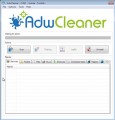Xifeua is a malicious Chrome extension that looks the entire traffic generated by you and on this basis, it displays a ton of intrusive popup ads. The extension may insert a lot of ads directly to the web-sites that you visit, creating a sense that these ads has been added by the creators of the site. Moreover, a legal advertising banners may be replaced on the fake ads, that will offer to download and install various unnecessary and malicious software. Moreover, the addon has the ability to collect lots of personal information about you (your ip address, what is a web page you are viewing now, what you are looking for on the Net, which links you are clicking), which can later transfer to third parties.
The malicious extension usually affects only the Google Chrome, Internet Explorer, FF and Edge by changing the internet browser’s settings. Moreover, possible situations, when any other web-browsers will be affected too. A malware will perform a scan of the machine for web-browser shortcuts and modify them without your permission. When it infects the web browser shortcuts, it’ll add the argument such as ‘http://site.address’ into Target property. So, each time you start the browser, you will see an unwanted Xifeua web-site.
Instructions which is shown below, will allow you to clean your PC from the Xifeua harmful addon as well as delete all intrusive popups from the Google Chrome, Firefox, Internet Explorer and Edge and other web-browsers.
How to remove Xifeua extension
Without a doubt, the add on is harmful to your system. So you need to quickly and completely remove this Xifeua plugin which developed to redirect your browser to various ad web sites. To remove this harmful addon, you can use the manual removal instructions that are given below or free malicious software removal tool such as Zemana Anti-malware, Malwarebytes or AdwCleaner (all are free). We recommend you use automatic removal solution that will allow you to remove Xifeua virus easily and safely. Manual removal is best used only if you’re well versed in PC system or in the case where malicious extension is not removed automatically. Read this manual carefully, bookmark or print it, because you may need to exit your browser or reboot your system.
Manual Xifeua removal
The following instructions is a step-by-step guide, which will help you manually remove Xifeua virus from the Google Chrome and other browsers.
Removing the Xifeua, check the list of installed programs first
In order to remove potentially unwanted software like this malicious extension, open the Windows Control Panel and click on “Uninstall a program”. Check the list of installed software. For the ones you do not know, run an Internet search to see if they are malicious addon, browser hijacker infection or PUPs. If yes, uninstall them off. Even if they are just a software that you do not use, then removing them off will increase your PC start up time and speed dramatically.
Windows 10, 8.1, 8
Click the Microsoft Windows logo, and then click Search ![]() . Type ‘Control panel’and press Enter as shown in the figure below.
. Type ‘Control panel’and press Enter as shown in the figure below.
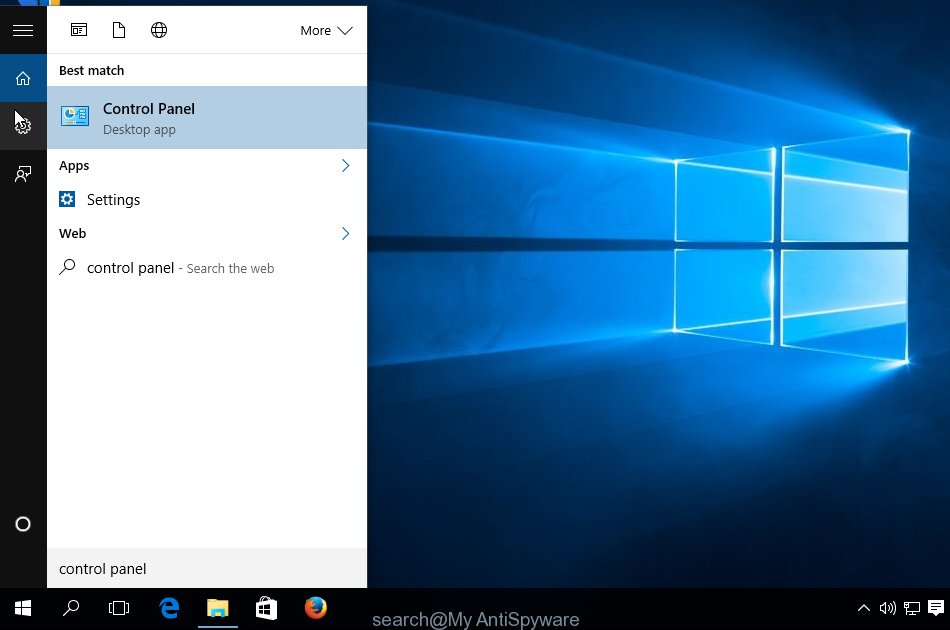
Once the ‘Control Panel’ opens, click the ‘Uninstall a program’ link under Programs category as shown on the image below.
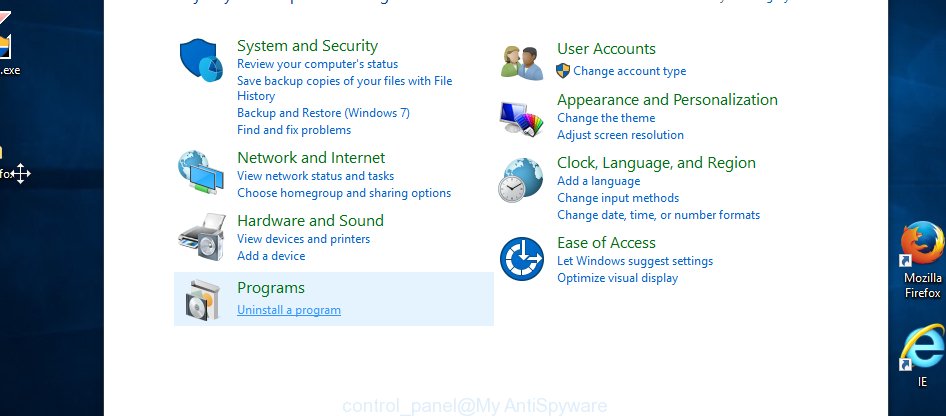
Windows 7, Vista, XP
Open Start menu and select the ‘Control Panel’ at right as shown on the image below.
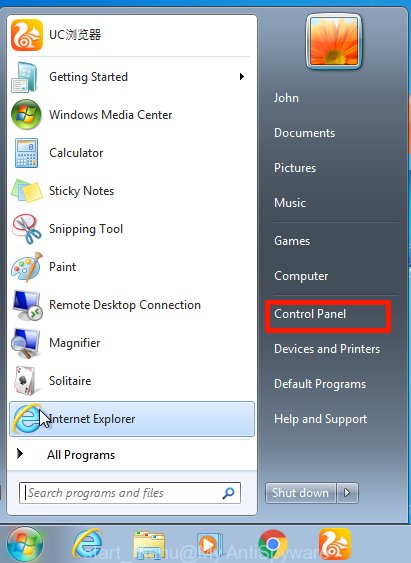
Then go to ‘Add/Remove Programs’ or ‘Uninstall a program’ (Windows 7 or Vista) as shown below.
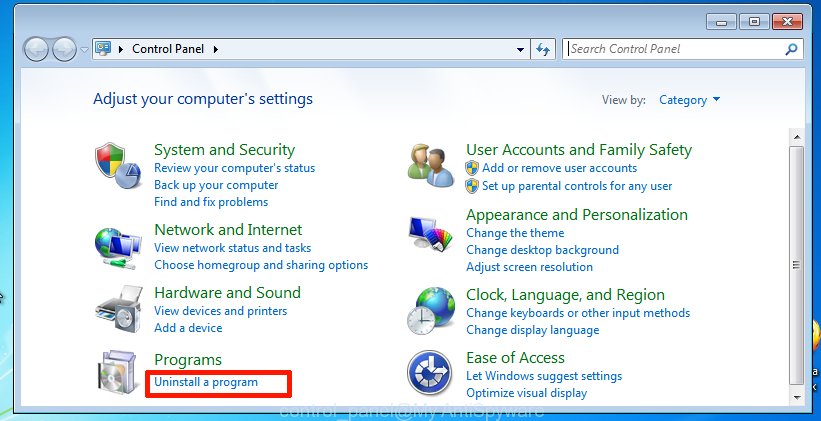
Carefully browse through the list of installed applications and remove all programs which has the name similar to the Xifeua. We recommend to click ‘Installed programs’ and even sorts all installed programs by date. Once you have found anything suspicious that may be the hijacker infection, adware or PUPs, then select this application and click ‘Uninstall’ in the upper part of the window. If the suspicious application blocked from removal, then run Revo Uninstaller Freeware to fully delete it from your computer.
Fix infected browsers shortcuts
A malware can hijack various Windows shortcuts on your desktop (most often, all internet browsers shortcuts), so in this step you need to check and clean them by removing the argument like http://site.address/.
To clear the web browser shortcut, right-click to it and select Properties. On the Shortcut tab, locate the Target field. Click inside, you will see a vertical line – arrow pointer, move it (using -> arrow key on your keyboard) to the right as possible. You will see a text such as “http://site.address” which has been added here. You need to delete it.

When the text is removed, click the OK button. You need to clean all shortcuts of all your internet browsers, as they may be infected too.
Remove Xifeua virus from Chrome
Reset Google Chrome settings is a simple way to delete the malicious extension, malicious and adware extensions, as well as to recover the web-browser’s newtab, startpage and search engine by default that have been replaced by Xifeua harmful extension that reroutes your web browser to intrusive ad pages.
Open the Chrome menu by clicking on the button in the form of three horizontal stripes (![]() ). It will show the drop-down menu. Next, click to “Settings” option.
). It will show the drop-down menu. Next, click to “Settings” option.

Scroll down to the bottom of the page and click on the “Show advanced settings” link. Now scroll down until the Reset settings section is visible, as shown below and click the “Reset settings” button.
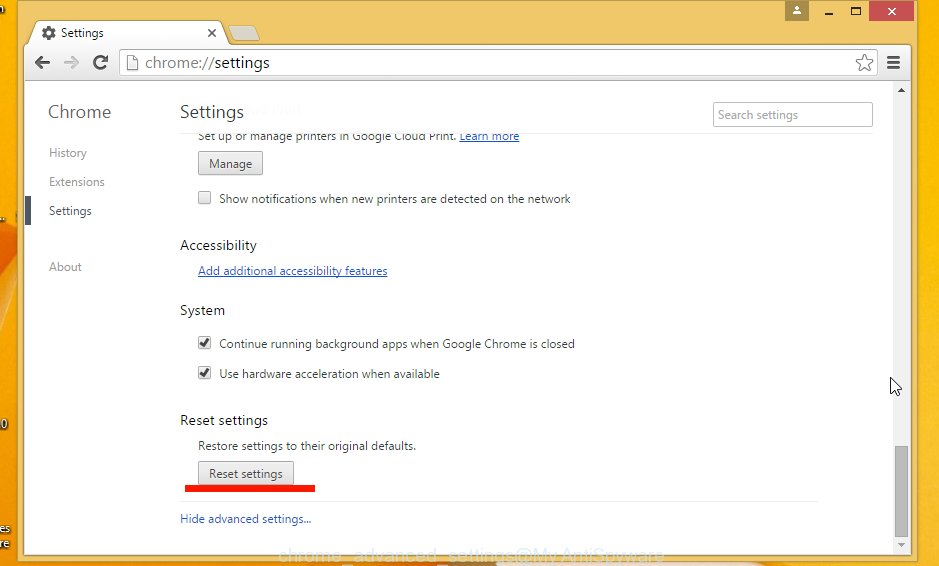
Confirm your action, click the “Reset” button.
Get rid of unwanted Scheduled Tasks
Once installed, the virus can add a task in to the Windows Task Scheduler Library. Due to this, every time when you run your personal computer, it will open an annoying web site. So, you need to check the Task Scheduler Library and delete all malicious tasks that have been created by unwanted applications.
Press Windows and R keys on the keyboard at the same time. This displays a prompt that titled with Run. In the text field, type “taskschd.msc” (without the quotes) and click OK. Task Scheduler window opens. In the left-hand side, click “Task Scheduler Library”, as shown in the figure below.
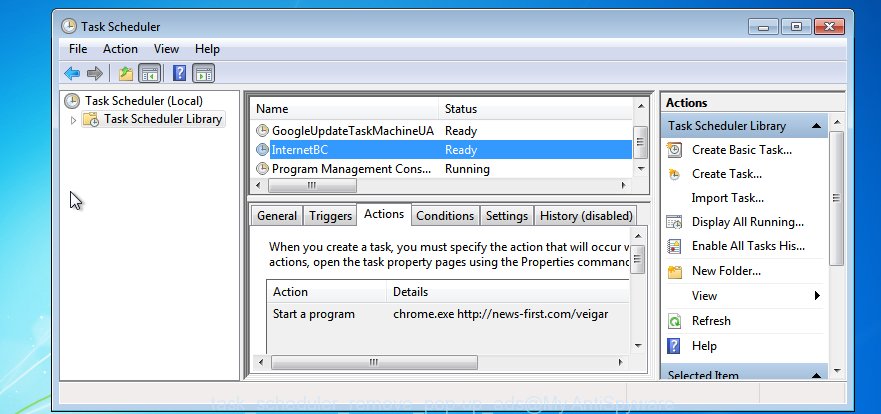
Task scheduler
In the middle part you will see a list of installed tasks. Please select the first task, its properties will be open just below automatically. Next, click the Actions tab. Pay attention to that it launches on your PC. Found something like “explorer.exe http://site.address” or “chrome.exe http://site.address”, then get rid of this harmful task. If you are not sure that executes the task, check it through a search engine. If it is a component of the adware, then this task also should be removed.
Having defined the task that you want to remove, then click on it with the right mouse button and choose Delete as shown on the image below.

Delete a task
Repeat this step, if you have found a few tasks that have been created by ‘ad-supported’ applications. Once is done, close the Task Scheduler window.
Get rid of Xifeua malicious plugin with free programs
If your personal computer is still infected with Xifeua extension which causes annoying pop-ups, then the best way of detection and removal is to run an antimalware scan on the machine. Download free malware removal utilities below and start a full system scan. It will help you get rid of all components of the add-on from hardisk and Windows registry.
Automatically remove Xifeua virus with Zemana Anti-malware
We recommend you to run the Zemana Anti-malware that are completely clean your PC system of Xifeua virus. Moreover, the utility will help you to delete PUPs, malicious software, toolbars and browser hijacker infections that your machine may be infected too.
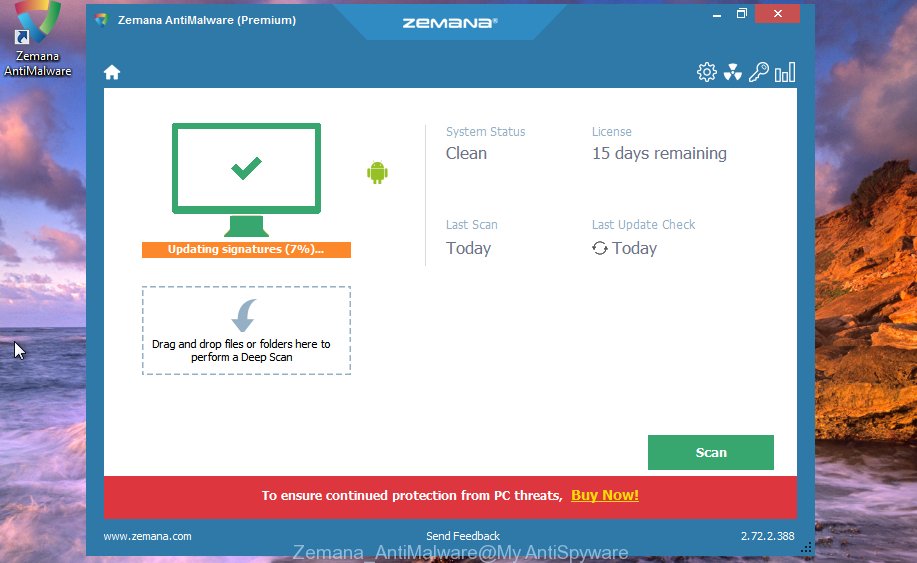
- Please download Zemana Anti-Malware to your desktop from the following link.
Zemana AntiMalware
165053 downloads
Author: Zemana Ltd
Category: Security tools
Update: July 16, 2019
- At the download page, click on the Download button. Your internet browser will open the “Save as” dialog box. Please save it onto your Windows desktop.
- Once the downloading process is done, please close all software and open windows on your system. Next, run a file named Zemana.AntiMalware.Setup.
- This will run the “Setup wizard” of Zemana Anti-Malware onto your personal computer. Follow the prompts and don’t make any changes to default settings.
- When the Setup wizard has finished installing, the Anti-Malware will launch and display the main window.
- Further, click the “Scan” button for scanning your PC for the Xifeua harmful add on which made to redirect your web browser to various ad web-pages. This procedure can take quite a while, so please be patient.
- Once it has completed scanning, it’ll show you the results.
- Review the report and then click the “Next” button. The utility will remove Xifeua addon which designed to redirect your web-browser to various ad web-sites and add items to the Quarantine. After disinfection is finished, you may be prompted to reboot the computer.
- Close the Zemana Anti Malware and continue with the next step.
Run Malwarebytes to remove Xifeua virus
We suggest using the Malwarebytes Free which are completely clean your PC of the harmful add on. The free utility is an advanced malicious software removal application designed by (c) Malwarebytes lab. This program uses the world’s most popular anti-malware technology. It is able to help you delete intrusive Xifeua from your web-browsers, PUPs, malicious software, browser hijackers, toolbars, ransomware and other security threats from your PC system for free.
Download Malwarebytes by clicking on the link below.
327278 downloads
Author: Malwarebytes
Category: Security tools
Update: April 15, 2020
When the download is finished, close all applications and windows on your computer. Open a directory in which you saved it. Double-click on the icon that’s called mb3-setup like below.
![]()
When the setup begins, you will see the “Setup wizard” which will help you install Malwarebytes on your machine.
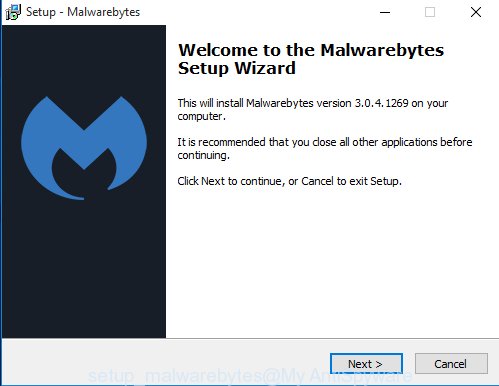
Once installation is complete, you will see window as on the image below.
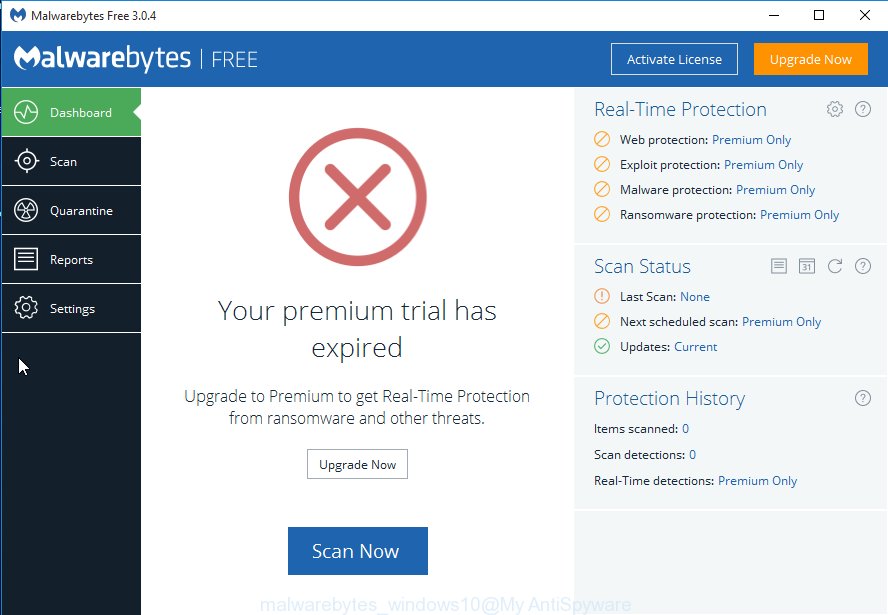
Now press the “Scan Now” button It’ll scan through the whole PC system for the Xifeua virus which reroutes your browser to intrusive ad web-pages. Depending on your PC, the scan can take anywhere from a few minutes to close to an hour. While the utility is checking, you may see number of objects it has identified either as being malicious software.
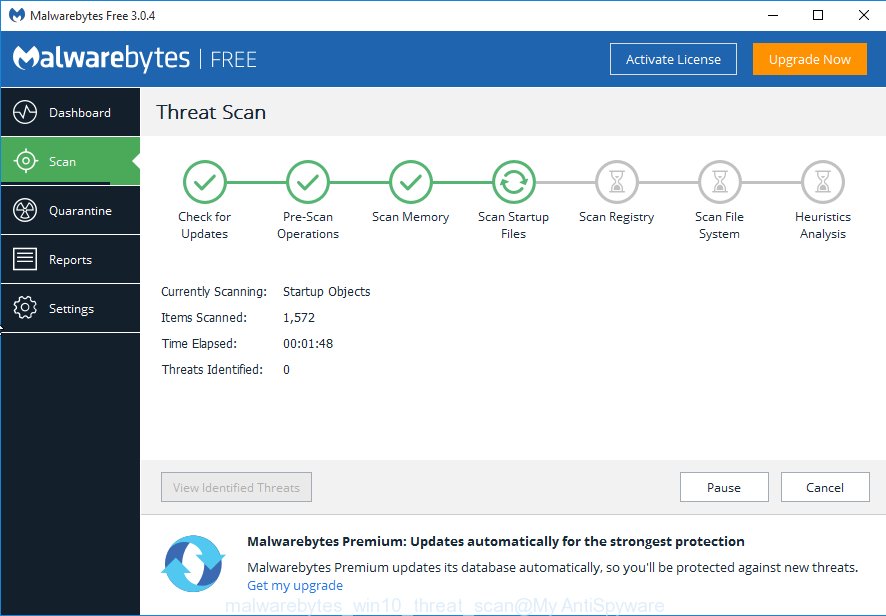
Once finished, it will open a list of all threats found by this utility. Make sure all items have ‘checkmark’ and click “Quarantine Selected” button.
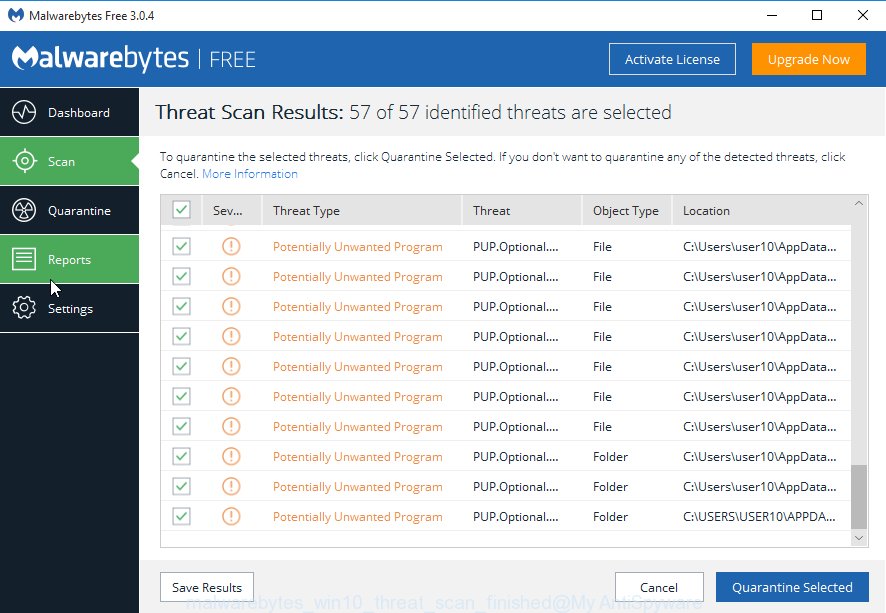
The Malwarebytes will now get rid of Xifeua add on which redirects your web browser to annoying ad web pages. After that process is done, you may be prompted to restart your personal computer.
The following video explains step by step tutorial on how to get rid of browser hijacker infection, adware and other malicious software with Malwarebytes Anti-malware.
If the problem with Xifeua is still remained
If MalwareBytes anti-malware or Zemana antimalware cannot get rid of this extension, then we recommends to run the AdwCleaner. AdwCleaner is a free removal utility for browser hijacker infections, potentially unwanted applications, toolbars and Xifeua virus that causes a lot of annoying pop-up ads.
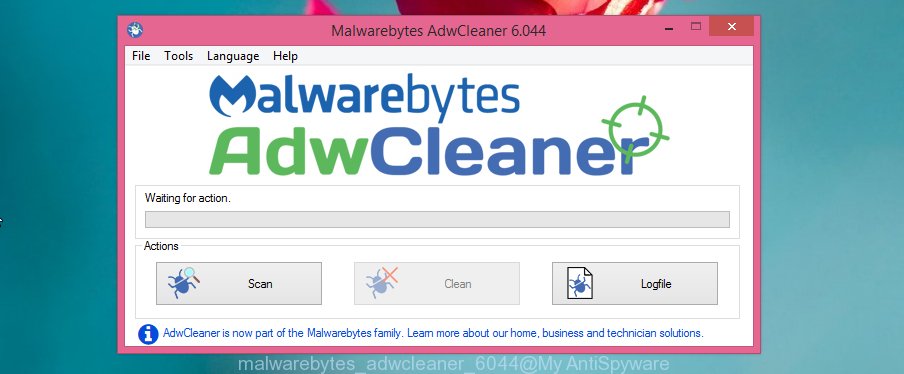
- Download AdwCleaner from the following link.
AdwCleaner download
225634 downloads
Version: 8.4.1
Author: Xplode, MalwareBytes
Category: Security tools
Update: October 5, 2024
- Select the folder in which you saved it as Desktop, and then press Save.
- When downloading is complete, launch the AdwCleaner, double-click the adwcleaner_xxx.exe file.
- If the “User Account Control” prompts, click Yes to continue.
- Read the “Terms of use”, and click Accept.
- In the AdwCleaner window, press the “Scan” It will scan through the whole machine for the Xifeua extension which created to reroute your web browser to various ad web pages. When a threat is detected, the count of the security threats will change accordingly. Wait until the the scanning is finished.
- Once it has finished scanning, the results are displayed in the scan report. You may move threats to Quarantine (all selected by default) by simply click “Clean”. If the AdwCleaner will ask you to restart your computer, press “OK”.
The instructions shown in detail in the following video.
Use AdBlocker to stay safe online
By installing an ad blocking program like AdbGuard, you’re able to stop browser redirects, autoplaying video ads and remove tons of distracting and unwanted ads on sites.
- Download AdGuard application by clicking on the following link.
Adguard download
26903 downloads
Version: 6.4
Author: © Adguard
Category: Security tools
Update: November 15, 2018
- After downloading is finished, start the downloaded file. You will see the “Setup Wizard” program window. Follow the prompts.
- Once the installation is done, click “Skip” to close the installation program and use the default settings, or press “Get Started” to see an quick tutorial which will allow you get to know AdGuard better.
- In most cases, the default settings are enough and you do not need to change anything. Each time, when you launch your PC system, AdGuard will start automatically and stop advertisements, as well as other harmful or misleading pages. For an overview of all the features of the program, or to change its settings you can simply double-click on the icon named AdGuard, which is located on your desktop.
Final words
Now your computer should be free of the Xifeua virus that causes internet browsers to show unwanted popups. Delete AdwCleaner. We suggest that you keep AdGuard (to help you block unwanted pop-ups and undesired malicious web-pages) and Zemana Anti-malware (to periodically scan your machine for new malicious software, hijackers and ‘ad supported’ software). Make sure that you have all the Critical Updates recommended for Windows OS. Without regular updates you WILL NOT be protected when new hijacker infections, malware and ‘ad supported’ software are released.
If you are still having problems while trying to remove Xifeua malicious plugin from your internet browser, then ask for help in our Spyware/Malware removal forum.

